PinotFile: 6.52 January 30, 2008
|
Pinot Noir Consumes OregoniansPinot Noir is the new darling of wine cognoscenti in California, but it was Cabernet Sauvignon and Chardonnay from Napa Valley that startled the world at the famous Paris Spurrier tasting in 1976 and established California as the foremost New World source for these two varietals. Oregon, on the other hand, staked its wine reputation on Pinot Noir from the beginning. In 1979, Robert Drouhin of the famed Domaine Drouhin in Burgundy, set up a blind tasting of French Burgundies versus American Pinot Noirs. At this now famous Gault-Mileu tasting held in Paris, a 1959 Domaine Drouhin Chambolle-Musigny came in first, but David Lett’s 1975 Eyrie Vineyards South Block Reserve Pinot Noir took second. 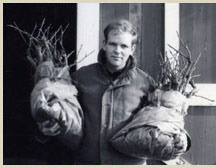
Driven by a string of excellent hot and dry vintages beginning in 1998 and extending to 2003, Oregon’s Pinot Noirs have reached world-class critical acclaim. People still think Oregon is rife with hippies making wine out of garages in their backyards. This may have been true back in the 1970s, but today Oregon Pinot Noir is crafted by a group of highly-educated, talented and dedicated winegrowers. They may still sport beards, ponytails, checkered shirts and a laid back attitude, but the Pinot Noir they produce rivals any in the world. Despite the advances in quality of Oregon Pinot Noir, some of the criticisms leveled at Oregon winemakers of late include the over reliance on single vineyard bottlings which lack true distinction, the escalating prices (comparable to California, however), and the trend toward wines that are Caliesque in fruitiness and extravagance. Paul Gregutt, writing in the Wine Enthusiast (October, 2007) notes, “A disheartening number make bulked-up wines that are so saturated in color, slathered in oak, and reeking of alcohol, that they could pass for Zinfandel or Syrah. As a critic, I may reward such behavior. But as a consumer, I want my Pinot to show elegance and breed. I want more texture, less barrel.” He concludes, “Oregon’s potential far exceeds its accomplishments to date.” David Lett was recently quoted as saying, “Pinot Noir should be a princess, not a monster. Who would you rather eat with?” Noted wine writer Matt Kramer has pointed out that winegrowers have become too dependent on “flavor-potent” Dijon clones that are picked very ripe. He feels this results in a sameness to the wines that obscures the site from which they originate. I have been puzzled myself by the mind-boggling number of single-vineyard bottlings. To be sure, there are a few established and recognizable vineyards that merit vineyard-designate bottlings in Oregon such as Shea Vineyard, Seven Springs Vineyard, Privé Vineyard and Maresh Vineyard, but many others’ only justification seems to be the opportunity to charge a higher price. Blended wines can be just as good and are not as subject to the vagaries of the vintage. To be fair, California has been guilty of this fetish with vineyard-designate Pinot Noirs as well. I do not feel the style controversy that consumes wine critics of Oregon Pinot Noir (as well as California) personally overwhelming for I believe in diversity and I enjoy them all. We should not champion a one-size-fits-all model of Pinot Noir. As much as I prize moderate alcohol, exquisite balance, structural elegance, judicious oak, and sublime texture over showy fruit, many consumers enjoy a fruity, flirty New World Pinot Noir infused with hedonism. In the pages to follow, you will find an extensive tasting of 2005 and 2006 Oregon Pinot Noirs in all styles from opulent and sexy to elegant and sensual. The tasting notes are intended to give you a feel for the wine’s style and appeal, a starting point for you to explore further through your own palate. A few relevant comments on the 2005 and 2006 vintages in Oregon may be helpful. Rain is synonymous with Oregon, but unfairly so, for in the Willamette Valley, there is no more rain than other cool climate wine growing regions of the world. That is not to say that rain isn’t a problem, for much of Oregon’s rainfall occurs in the spring and fall (as well as throughout the winter), with dry conditions only in mid-summer. From 1998 to 2003, Oregon enjoyed a string of hot, dry vintages without significant rain pressure. However, from 2004 to 2007, rain was a significant influence on each vintage. In 2004, rains in September receded before final ripening and the vintage turned out to have low yields with superbly balanced flavors, acidity and tannins. 2005 was shouldered with rain and cool weather in the spring and at harvest. It was a challenging vintage with irregular flowering. Harvest was extended, lasting into November for several wineries. Like 2004, the wines are of high quality, nicely balanced, and with excellent acidity. In 2006, there was higher than normal rainfall in the winter and a dry summer leading to record high yields. Considered a ripe, California-type vintage with a little higher alcohols, the few wines that have been released show great promise. The advances in viticulture in Oregon have enabled the winegrowers here to craft quality Pinot Noir despite challenging weather during the growing season. It is interesting to read an article by James Laube in the Wine Spectator from 1993 on Pinot Noir titled “American Pinot Noir: A Work in Progress.” (February 28, 1993). It was the consensus at the time that there were few good winemakers and the wineries were too poor to afford the best equipment. Winemakers were learning on the job and still discovering the best vineyard and winemaking techniques. They were plagued by flaws and inconsistencies in their wines. It was clear, however, that the winemakers were undaunted and as William Hill, founder of the Van Duzer label said, “I’ve never seen such an intensely committed group of wine artists in my life.” Their commitment has paid off.
Ponzi Vineyards Dick and Nancy Ponzi established Ponzi Vineyards in 1970 in Beaverton, Oregon, 15 miles southwest of Portland. Dick has been active in promoting Oregon’s wine industry for years. He was a founding member and first president of the Oregon Winegrowers Association, and served as a founding Director of the Oregon Wine Advisory Board (now the Oregon Wine Board). Nancy helped create the first Discover Oregon Wines guide, co-founded the International Pinot Noir Celebration, the Salud Oregon Pinot Noir Barrel Auction and, most recently, Oregon Pinot Camp. In 1997 they created a regional tasting room and a full service restaurant showcasing local wines and food called The Dundee Bistro. Ponzi Vineyards is one of Oregon’s top 20 Oregon wineries by brand in 2007 with an estimated case production of 29,600. Ponzi Pinot Noirs have won critical acclaim through the years. The wines have always been intense, savory and concentrated. Consistency has always been a hallmark, even during the uneven vintages of the 1990s. My Oregon wine epiphany was a 1992 Ponzi Reserve Pinot Noir made from a single vineyard that was 18 years old at the time and I have continued to enjoy many Reserve bottlings since. The three Ponzi children, Michel (Operations Manager) , Anna Maria (National Sales and Marketing Director) and Luisa (Winemaker), grew up helping out in the vineyard and in the family’s winery and operate the family business now. They are continuing the family tradition of community and wine industry service. Even their eight grandchildren are now being introduced to viticulture and the operation of the winery at an early age. Luisa is a highly respected winemaker who was trained in Burgundy and now is married to another notable winemaker, Eric Hamacher. The Oregon Wine Board recently presented Dick and Nancy Ponzi with a Lifetime Achievement Award at the annual Oregon Wine Symposium in Eugene, Oregon. The award is put forth by colleagues currently working in the Oregon wine industry. A new Ponzi winemaking facility is due for completion for the 2008 harvest. It is located closer to their vineyards on the east and north faces of the Chehalem Mountains. The property, as yet unnamed, is 42 acres and is being designed by Dick Ponzi. The tasting room will remain at its current location.
2006 Ponzi Vineyards Tavola Willamette Valley Pinot Noir 13.5% alc., $25, 4,000 cases, screw cap. A blend of six vineyards. · Light in color. Nice cherry aromatics, modest and pleasant red fruits with an herbal and chocolate note and healthy acidity. A great picnic wine.
 2005 Ponzi Vineyards Willamette Valley Pinot Noir 13.8% alc., $35, 4,666 cases. A blend of grapes from five vineyards. · Complex nose featuring dark berries and cherries with earthy, woodsy and floral highlights. Dark Pinot fruits, herbal but not herbaceous, soft and full, with a viscous mouth feel, clean finish and an oaky edge to the aftertaste.
2005 Ponzi Vineyards Reserve Willamette Valley Pinot Noir 13.6% alc., $60, 3,000 cases. Sourced primarily from the Chehalem Mountain AVA including estate Madrona, Aurora and Abetina vineyards. Aged for 20 months in 50% new French oak. · Aged for 20 months in 50% new French oak. This has a “Oh! My God” nose showing crushed black cherries and baking spices. Very lovely. Dark berry-cherry fruit which is velvety on the palate. Seamless. Very good and maybe even orgasmic. Don’t miss this one.
2005 Ponzi Vineyads Il Luce Willamette Valley Pinot Noir 13.5% alc., $100, 600 bottles, etched bottle. From a 1-acre estate vineyard planted in 2003 with clone 777. · The wine is driven by black cherry and black berry flavors so typical of clone 777. Sandalwood and floral accents enhance the shy aromatics. A decent wine with good intensity and firm tannins, but like a teenager, lacks maturity and is still a bit awkward. Plan to cellar this one.
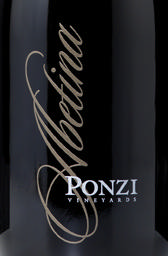 2005 Ponzi Vineyards Abetina Willamette Valley Pinot Noir 13.5% alc., $100, 1200 bottles, etched bottle. From a 2-acre vineyard established in 1975 and planted to 20 different clones. Grapes from this vineyard are often put into the Reserve Pinot Noir. This wine is only made in exceptional vintages. · Wow, superlatives just don’t do this outrageous wine justice. A BIG tasty wine that reminds me of a 2004 Mugnier Bonnes Mares that I drank the night before with a little more New World punch. Plush black cherry extract, dark chocolate, gingerbread and spice. Impeccable balance with a solid tannic backbone for aging and a sensuous satiny texture. Fine to drink now for its hedonism, but this will improve over the next five years. This is just plain terrific and what I affectionately call a “glamazon.”
Ponzi Vineyards has two tasting rooms. The original tasting room is located at the site of the first estate vineyards and winery at 14665 SW Winery Lane in Beaverton and is open from 11-5 daily. Tours are available by appointment (503-628-1227). The Ponzi Wine Bar is located at 100 SW 7th St in Dundee and is open from 11-5 daily (503-554-1500). The wines are distributed by Wilson Daniels and sold on the website at www.ponziwines.com.
Laura Volkman VineyardsLaura Volkman calls herself a New World winegrower with an old world philosophy. “we let the fruit make the wine.” Hard work in the vineyard is aimed at farming balanced vines that produce wines true to the varietal and the vintage. The wines are handcrafted using gravity flow techniques at August Cellars (a cooperative facility in which several winemakers lease space) in Newberg. The Volkman Vineyard is located a ¼ mile up the hill from the winery. 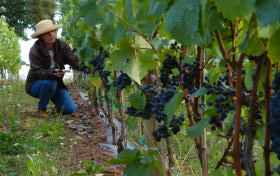 For the 2006 vintage, she has three Pinot Noirs and a Chardonnay. The Jacob Estate Pinot Noir (14.4% alc., 135 cases, $42) is her flagship wine sourced from the east block of the Volkman Vineyard. The clones are 114, 115 and 777. This is the most robust and more darkly fruited of her Pinot Noirs. The Rachel Estate Pinot Noir (14.2% alc., 135 cases, $38) is from the west block of the Volkman Vineyard and includes clones 114, 667 and Pommard. It is a little more feminine and pretty wine. The two estate Pinot Noirs will be released in May, 2008 and I am anxious to try them. The labels are quite striking and the artwork depicting Laura in her vineyard is by watercolor artist Terry Peasley (www.terrypeasleyart.com)
2006 Laura Volkman Vineyards Bella Oregon Chardonnay 13.8% alc., $25. · Clear bright yellow in color. Yeasty aromatics followed by poised citrus, herb and oak flavors nicely composed. Brisk acidity leads to a clean and refreshing finish. I like this a lot. Now that proper clones of Chardonnay are planted in Oregon and winemakers used to crafting Pinot Noir have got the hang of it, there are many impressive examples of Chardonnay now being offered throughout the state.
2006 Laura Volkman Vineyards St. James Estate Private Reserve 14.4% alc., $30. She says this “cute little cuvee was made for my husband but it’s too good to drink all by himself.” Several Dijon clones with a small amount of Pommard blended in. · On the nose there are dark red fruits, a little good funk, and a hint of oak. Brisk and lively in the mouth with spiced cherries and berries and a complimentary citrus note. Very clean mouth feel. Perfectly fine.
Laura Volkman Vineyards address is 13000 N.E. Quarry Road (off 99W), Newberg (August West Cellars). Tasting by appointment. The wines are sold through a mailing list or by contacting Laura at 503-806-4047. Discount for case purchases. The website is www.volkmanvineyards.com.
Anam Cara CellarsNick and Sheila Nicholas lovingly farm a 30-acre vineyard on the southeast slopes of the Chehalem Mountains, just north of the town of Newberg. Five blocks of Pinot Noir were planted in 2000 and 2001 with Dijon clones 114, 115, 667, and 777 and Pommard. There are a total of 28 acres of Pinot Noir, 1 acre of Riesling and 1 acre of Gewürztraminer. The property had been an overgrown walnut, plum and hazelnut orchard with a neglected Christmas tree forest and included a quaint farmhouse dating from 1902. The words Anam Cara are Celtic for “friend of my soul” and symbolize the journey the Nicholas’s have taken to farm their vineyard sustainably and craft their wine. The Anam Cara label depicts the vineyard and the entwined vines logo symbolizes the owner’s relationship with their land and with each new friend who shares their wine. I first tasted the 2005 Anam Cara Cellars Pinot Noirs at this past year’s International Pinot Noir Celebration and was quite taken by them. Recently I was able to sit down and spend time with each of the three bottlings and my initial favorable impressions were confirmed. The wines are made at a custom crush facility, Twelfth and Maple Wine Co, close by in Dundee.
2006 Anam Cara Cellars Heather’s Vineyard Chehalem Mountains Pinot Noir 15.0% alc., 50 cases, $65. This wine is named after the Nicholas’s daughter and is the most feminine wine in the lineup. Sourced from a 5-acre block of Dijon 114. · Aromas of ripe black cherries, herbs and oak char. Smooth and velvety in the mouth with rich but not jammy dark stone fruits and berries, herbs and a deft touch of oak. Clean and juicy with a refreshing acid driven tang on the finish. I like this wine for its elegance.
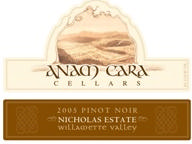 2005 Anam Cara Cellars Nicholas Estate Chehalem Mountains Willamette Valley Pinot Noir 13.7% alc., 678 cases, $30. This is a blend of all five blocks of the estate vineyard. Aged in 25% new French oak. · Alluring scents of spiced cherries lead to a soft, smooth and elegant wine packed with charming red and black Pinot fruits and faultless oak integration. The lingering finish displays a peacock tail of fruits and spices. A great expression of Pinot Noir.
2005 Anam Cara Cellars Nicholas Estate Reserve Chehalem Mountians Willamette Valley 13.7% alc., 213 cases, $42. A blend of a few special barrels from the estate vineyard. · Noticeably bigger and fruitier than the above wine featuring blackberry and black cherry flavors with hints of spice and smoke. A little more fullness on the palate and a little more chewy. Beautifully balanced. This wine is still a bit shy and needs a few years in the cellar to show all of its charms.
2005 Anam Cara Cellars Heather’s Vineyard Chehalem Mountains Willamette Valley Pinot Noir 13.7% alc., 75 cases, $60. This inaugural release originates from three barrels from a single 5-acre block of Dijon clone 114 vines that were remarkable for their softness and complexity. The wine takes its inspiration from daughter Heather Nicholas. · Heady ripe cherries, wild berries and raisins lead the flavor parade. Very smooth, even glossy, with seamless elegance and a touch of bitterness on the lengthy finish. Still a little reticent but on its way to many surprises.
Anam Cara Cellars wines are available on the website at www.anamcaracellars.com or by phone at 503-537-9150. Limited Edition Wine Club members receive twice yearly mailings of six bottles of limited production Anam Cara Cellars estate wines including Pinot Noir, Riesling and Gewürztraminer.
Westrey Wine CompanyAmy Wesselman may be best known as the Executive Director of the annual International Pinot Noir Celebration in McMinnville, Oregon, but she is also a terrific winemaker. Together with co-winemaker David Autrey, the two founded Westrey Wine Company in 1993. The name Westrey comes from their collaborative winemaking effort (Amy WESselman and David AuTREY). Each has had extensive winemaking experience (Amy at Oregon’s Bethel Heights, Rex Hill and The Eyrie Vineyards and Burgundy’s Domaine de L’Arlot; David at Oregon’s Adelsheim, Cameron and Burgundy’s Domaine Dujac). The two met while studying philosophy at Reed College in Portland and their philosophy of winemaking is nicely summed up in their tag line: “Texture and terroir amidst post-industrial splendor.” Initially Westrey owned no vineyards but sourced from some of Oregon’s top vineyards including Croft, Abbey Ridge, Bethel Heights, Temperance Hill, Anderson Family and Laurel Hood. In 2002, they purchased around 50 acres in Yamhill County adjacent to Abbey Ridge Vineyard and planted 5 acres to vines. This was advantageous for they had worked with Abbey Ridge Vineyard fruit for several years. Starting with 400 cases in 1993, Westrey currently produces around 3,200 cases, with a goal of reaching 6,000 to 8,000 cases over the next ten years. In their winemaking, new oak is kept to a minimum for Pinot Noir and Chardonnay. The Alsatian-inspired Pinot Gris sees no oak or MLF. Their style is a departure from many Oregon producers with an emphasis on structure, texture and aging potential. To that end, their wines tend to have higher acidity, a nod to their Burgundian training.
 2006 Westrey Willamette Valley Pinot Noir 13.5% alc., $18. · The nose is shy but quite charming featuring red Pinot fruits. On the palate, there is a panoply of red fruits including cranberry, pomegranate and raspberry enhanced with a subtle oak flourish. The finish is tangy and refreshing and the overall balance is spot on. A very attractive wine which oozes finesse and well worth the tariff..
Westrey Wine Company is located at 1065 NE Alpine St, McMinnville. The phone is 503-434-6357. The wines, including older vintages, are available at www.northwest-wine.com. Prices are very sensible, ranging from $18 to $36. the website is www.westrey.com. I am sure Amy or David would be happy to have you taste by appointment. 
International Pinot Noir Celebration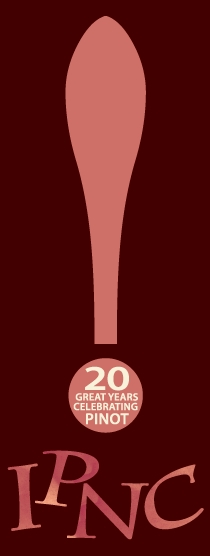 This is the granddaddy of all Pinot Noir Festivals, now entering its 22nd year. This summer’s IPNC will be July 25-27, 2008. The theme is “Sustainability Without Sacrifice” and the featured winemaker is Dominique Lafon from Meursault, France. The number of guests is limited to 700 to ensure the intimate atmosphere of the event, so don’t delay to register if you plan to attend. For information and registration visit the website at www.ipnc.org or phone 800-775-IPNC. Accommodations are limited in the Willamette Valley so plan ahead. The student rooms on campus are a bit spartan, but are comfortable and within walking distance to all event activities. This celebration of Pinot Noir is unique for several reasons. First, it is held on a small bucolic college campus, Linfield College, in McMinnville. Second, all of the events including meals are held outdoors. Third, it is attended by more Burgundian vignerons than any other Pinot Noir Festival in North America. Fourth, the mix of attendees includes winemakers, winery owners, growers, wine distributors, wine retailers, wine writers and consumers, all in a good mix. Fifth. the event draws highly lauded chefs in the Pacific Northwest and feature the best artisan foods in the region. And finally, great Pinot Noir flows like water. If you plan to go, consider arriving a few days early or staying a few days afterwards to visit wineries (most require appointments) such as those featured in this issue. I will be attending as usual this year and I hope to see a contingent of the Crew there. There will be plenty of opportunity to meet and drink Pinot together. Please look me up.
Shea Wine Cellars & Shea VineyardFind Dick Shea in his polo shirt and jeans walking his vineyard and you would never guess this unassuming figure worked for years as a trader on the floor at Wall Street. As he says, “Quite a change from the pandemonium of that environment to the tranquility of the vineyard.” Years ago, Dick had decided to move his family out West, and while searching for an appropriate setting in the Northwest, he had his wine epiphany - a bottle of Adelsheim Oregon Pinot Noir. Oregon became his chosen spot, and with two east coast partners, he purchased land in the hills of Yamhill County in 1989. At the time, the Yamhill-Carlton District was largely untested for Pinot Noir. The Willakenzie soils which typified the region were considered inferior for grape growing to the popular Jory soils found in the nearby Dundee Hills. Concurrent with the planting of Shea Vineyard in 1989, the nearby Beaux Freres Vineyard (a partnership between Robert Parker and his brother-in-law Mike Etzel) was being established. Now the Shea Vineyard is surrounded by several other premier Pinot Noir vineyards including those owned by Willakenzie, Patricia Green and Penner-Ash. The Yamhill-Carlton District AVA, north of McMinnville now contains more than 1,200 acres of vineyards. The growing conditions here are ideal for grapes with the Coast Range of mountains to the west creating a rain shadow over the District and the ancient marine sediments that compose the soil draining quickly to create a natural deficit-irrigation effect. When asked the secret of his success, Dick told me that, “What I did right was putting a lot of effort into finding good people to advise me and later work for me. I have picked up my knowledge from them.” One of these people was viticulturist Javier Marin (pictured with Dick below) who has managed the vineyard from the beginning. In the early 1990s, Dick bought out his partners and remains the sole owner today. Shea Vineyard now consists of 200 hillside acres, of which 140 acres are planted to Pinot Noir and 5 acres to Chardonnay. The vineyard faces south at an elevation of 320 to 625 feet and is divided into two hills, named East and West separated by a valley containing native plants and trees. The original vines of Pommard and Wädenswil clones were planted on their own roots. Inevitably, phylloxera afflicted the vineyard and planned replanting progressed over the ensuing years, reaching completion in 2005. The newer plantings include the Dijon clones 114, 115, 777 and 828. The vineyard has never been irrigated except for new plantings during the first year. 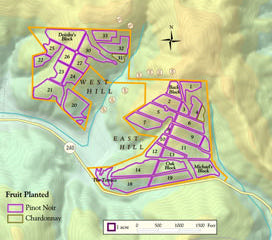 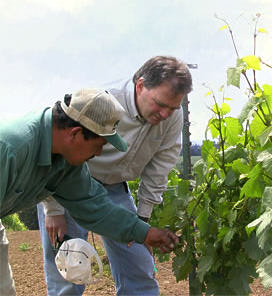 Grapes from this impeccably maintained site are highly sought after by many of Oregon’s top wineries including: Andres’s Vat, Antica Terra, Beaux Freres, Bergstrom, Broadley, Elk Cove, Francis Tannahill, J.K. Carrier, Ken Wright Cellars, Panther Creek Cellars, Penner-Ash, Raptor Ridge, Revana, Stevenson- Barrie, Scott Paul Wines, St. Innocent and Tori Mor. In the past, grapes were sent to Manfred Krankl at Sine Qua Non in California (last vintage 2003), but now grapes sent to California go to Loring Wine Co., Pali Wine Co., and Auteur. Dick told me a funny story about the vagaries of transporting grapes to California. One year the grapes had been picked and when the semi-truck showed up to haul the grapes to the Central Coast of California, the doors were opened and there was a strong smell of fish. Turns out, the refrigerated truck had just carried a large shipment of fish. Needless to say, the truck was sent away and a new truck brought in to transport the grapes. The vintage turned out fine for Krankl. Since 1996, Dick has had his own label, Shea Wine Cellars. 20% of the vineyard production is held back for Dick’s own label. Since 2004, Chris Mazepink (previously at Willamette Valley Vineyards and Lemelson) has been the full-time winemaker. Experienced tasters have talked about a certain “Shea-ness” that seems to be expressed in the wines from this vineyard. A consistent floral aroma and a dark red fruit character with spice seems unusually clear and unique to this vineyard. The Shea Wine Cellars Pinot Noirs are designated as Estate (a blend of several blocks), block or clone designates which vary from year to year, and a special reserve wine labeled “Homer.” Dick Shea is a baseball fan, but bears no relation to Shea Stadium in New York. Dick’s wife and business partner, Deirdre (pictured below with Dick in a cap and winemaker Chris Mazepink), often compares Dick to Homer Simpson, so the name “Homer” has dual meaning. The Homer cuvee is from the best barrels and is the most voluptuous of the lineup, needing several years to reach its prime drinking window. The Shea Wine Cellar Pinot Noirs have become a cult-classic collectible, eagerly sought after by Shea aficionados on the winery’s mailing list. 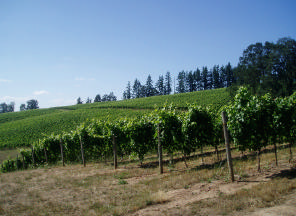 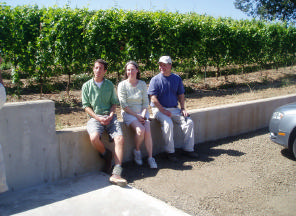 Recently I got together with members of Grape Radio to record a tasting of the 2005 vintage lineup of Shea Wine Cellars and Shea Vineyard wines as well as a couple of older vintages. The podcast may be heard at www.graperadio.com. 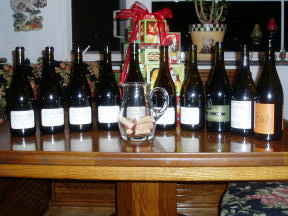 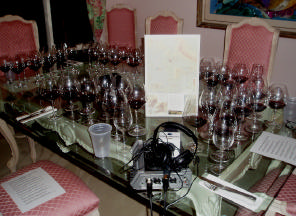

2006 Loring Wine Company Shea Vineyard Willamette Valley Pinot Noir 14.0% alc, $45. · Brian Loring’s first vintage under his label for this vineyard (he made the 2005 and 2006 Pali Shea Vineyard Pinot Noir) and he has crafted a beauty. Complex aromatics of blackberry, oak spice and pepper. The wine is darkly fruited, with slippery tannins, soft texture, and a nice toasty finish.
2005 Shea Wine Cellars Shea Vineyard Willamette Valley Chardonnay 14.15% alc., 245 cases, $35. Dick and Chris take Chardonnay seriously. This Chardonnay walks the line between the heavily-oaked, full-malo, buttery Chardonnays and the more austere, acidic Chablis-styled ones. Chris both barrel ferments and tank ferments the Chardonnay in separate lots and mixes the two together. The Chardonnay Dijon clone vines are cropped at less than two tons per acre like the Pinot Noir, resulting in Chardonnay with fine concentration and quality. Plans are to increase production to 600 cases a year. · Admirable crispness with tropical (banana), pear and citrus notes in the aromatics. Vanillin from oak adds interest. Terrific sipping wine or very appropriate for the table with shellfish.
2005 Shea Wine Cellars Estate Shea Vineyard Willamette Valley Pinot Noir 13.75% alc., 2,817 cases, $42. · Still a young wine that could benefit from decanting. Dark fruits and roseate aromas with earth, game and black raspberry on the palate finishing clean with lively acidity.
2005 Broadley Shea Vineyard Willamette Valley Pinot Noir 13.5% alc., $45. Broadley is a family-owned winery in Monroe in the southern Willamette Valley whose first release was in 1988. Sourced from old vines. · This wine showed more the redder fruit profile of this vineyard. Lightest in color and structure of all of the Shea Vineyard wines, with a noticeable brisk acidity and citrus kick on the backend. While the Auteur is more a sipping wine, this is more a table wine.
2005 Pali Wine Co. Shea Vineyard Willamette Valley Pinot Noir 14.0% alc., $45, screw cap. Dijon 114 clone, aged in 50% new French oak for 10 months. Brian Loring is the winemaker. · Beautifully expressive black cherry aromas, bright cherry and black raspberry fruit with a very subtle oak influence and some unresolved tannins on the backend. The second time I have tasted this wine and I found it immensely satisfying both times.
2005 Shea Wine Cellars East Hill Shea Vineyard Willamette Valley Pinot Noir 14.25% alc., 223 cases, $52. Dijon and Wädenswil clones from several blocks of younger vines on East Hill. · Deep, rich dark red fruits with a sidecar of oak echoed in the aromas and flavors. Velvety texture which is marvelous. Improves in the glass with time. Still reticent.
2005 Shea Wine Cellars Pommard Clone Shea Vineyard Willamette Valley Pinot Noir 14.4% alc., 195 cases, $52. Replaces Block 23 of years past. · Very shy nose initially that blossoms with air to reveal showy spice and floral scents. A big-boned wine with plenty of dark fruit and pomegranate flavor held in check by wellbalanced tannins and acid.
2005 Shea Wine Cellars Wädenswil Clone Shea Vineyard Willamette Valley Pinot Noir 14.25% alc., 316 cases, $52. Old vine plantings. · Noticeable but not intrusive oak throughout. Plenty of attractive spice and black fruit. Sensual soft texture. Lighter weighted than the above wines and to some tasters missing a little of punch in the mid-palate.
2005 Auteur Shea Vineyard Willamette Valley Pinot Noir This new label was started in 2004 by winemaker Kenneth Juhasz, who also makes wine for the Robert Stemmler label and The Donum Estate. Some whole cluster used, 55% new oak. · A sweet, lush and richly fruity wine that is big and powerful. Dark fruit driven and will appeal to those who love prodigious and succulent fruit in their Pinots. Some tasters felt the wine lacked complexity and would not age well but some found it very appealing.
2005 Ken Wright Shea Vineyard Willamette Valley Pinot Noir 13.5% alc., $60. Ken Wright crafts multiple single-vineyard Willamette Valley Pinot Noirs and his wines are superbly crafted. · A terrific wine of great charm and intensity with an alluring nose of brown-spiced cherries, cola and oak. Black cherry driven in the mouth with an appealing earthiness. Seamless in every way.
2005 Penner-Ash Shea Vineyard Willamette Valley Pinot Noir 13.5% alc., $60. Lynn Penner-Ash was formerly the winemaker at Rex Hill Vineyards and now has her own winery in Carlton. · The most attractive aromatics in the lineup featuring raspberry, cherry, and Xmas spice. Soft in the mouth, long in the finish, with lovely berry and cherry fruit that is soft and comforting on the palate. Delightful.
2005 Shea Wine Cellars Homer Shea Vineyard Willamette Valley Pinot Noir 14.25% alc., 247 cases, $75. Wädenswil and Dijon clone 115. · A huge fruit-driven wine with hi-toned and spiced black cherry fruit. Dense and brooding but with a pillowy texture and soft tannins. Cellaring would be advisable.
2003 Shea Wine Cellars Block 23 Shea Vineyard Willamette Valley Pinot Noir 14.2% alc., 275 cases, $48. 100% Pommard clone. · This wine reflects the hot vintage with super-ripe, almost baked fruit with noticeable oak accents on the backend. Low in acid, it is a bit flat and undistinguished.
2002 Shea Wine Cellars Block 23 Shea Vineyard Willamette Valley Pinot Noir 14.4% alc., $48. · I have enjoyed this wine on several occasions and this bottle was true to form. Complex aromatics featuring blackberries, black cherries, plum, wet earth and a little good funk. The dark fruit is sweet and tasty. The whole package is nicely balanced and with some tannins still to shed, will probably go several more years. Very good. This wine shows how nicely Shea Wine Cellars Pinot Noirs can age.
Shea Wine Cellars wines are sold primarily through a mailing list at www.sheawinecellars.com. Several Oregon retailers also carry at least the Estate bottling. The phone number is 503-241-6527. A new winery has been constructed on the vineyard estate and the 2006 vintage was the first made here. There is no tasting room. These are benchmark Pinot Noirs for the Yamhill-Carlton AVA and worthy of any pinotphile’s cellar. The words “Shea Vineyard” on any bottling pretty much guarantees a Pinot Noir with plenty of charisma. Winemaker Chris Mazepink talked to me about the recent 2007 vintage. He said he is reminded of the 2005 vintage in many ways such as the rain event that split harvest, as well as the style of wines that he is seeing early one in tank and press. The wines are a little lighter in alcohol than has been Oregon’s average over the last five years, but by no means watered down. Alcohols are in the 13.5%-14.0% range and there are some really fresh fruit characteristics coming off in tank. For Shea Wine Cellars it will be a blenders year as production has been raised to nearly 5,500 cases of Pinot Noir. The previous two biggest years were 2005 and 2006 at 4,000 cases, so it will be a real challenging or treat, depending on how you look at it, to start mixing and matching the 51 different lots that are created in the 2007 vintage.
Belle ValléeCalifornian Joe Wright arrived in Oregon in the early 1990s and learned his winemaker skills under the guidance of Joe Dobbes at Willamette Valley Vineyards. In 2002, he met Oregon natives Mike Magee and Steve Allen and they immediately struck up a friendship leading to a shared partnership. Fueled by their passion for Pinot Noir, they started Belle Vallée (Beautiful Valley) in a former tire warehouse in downtown Corvallis. Within 5 months, Joe had converted the 22,000 sq ft space into a winery of his design. The beautiful barrel aging room is the centerpiece (see next page). Belle Vallé has multi-year contracts with eighteen Oregon vineyards. Joe knows the vineyard owners and managers well from his years at Willamette Valley Vineyards and works closely with them. Joe is a blender rather than a single vineyard advocate. He believes blending several vineyards adds to the complexity, depth and character of the finished wine. In addition, sourcing several vineyards makes him less susceptible to the vagaries of the vintage. Every block from every vineyard is kept separate during the winemaking process, and then the barrels are painstakingly sampled and mixed to arrive at the final blend. The most magical barrels go into the Grand Cuvée bottling. The next level of quality is the Reserve and the remaining barrels are combined in the Willamette Valley blend. Joe also crafts an innovative Whole Cluster Pinot Noir for early drinking and a Pinot Noir Port that demands contemplation. 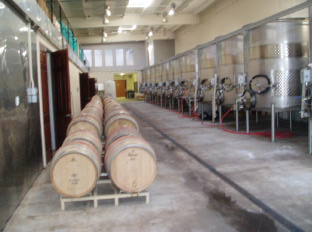 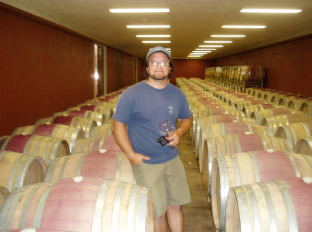 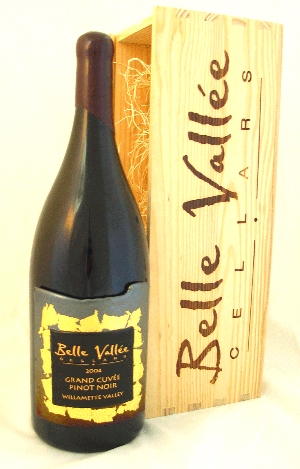
2006 Belle Vallée Cellars Whole Cluster Willamette Valley Pinot Noir 13.3% alc., $17. 100% whole cluster in a Beaujolais style meant to be drunk young. · A typical Beaujolais nose with confected cherries and tropical banana scents. Light and tutti-fruiti, this is a fun and casual wine best drank with a little chill.
2006 Belle Vallée Cellars Willamette Valley Pinot Noir 14.1% alc., $24. · A lighter styled Pinot Noir with a nice mix of fruit and oak. A smoky influence runs through. Very soft tannins and easy to drink.
2006 Belle Vallée Cellars Reserve Willamette Valley Pinot Noir 14.1% alc., $38, 11 months in 45% new French oak. Low yields from two vineyards, 50% Pommard, 50% clones 113, 115. · Plush red and black fruits are set off by a hint of oak char. Syrupy in texture, richly layered and possessing a healthy tannic backbone. A hearty wine that would welcome hearty foods.
2006 Belle Vallée Cellars Grand Cuvée Willamette Valley Pinot Noir 14.1% alc., 382 cases, $55. Aged for 11 months in 75% new French oak. 87½ % Pommard, 12½ % clone 115. Alpine Springs Vineyard and Vitae Springs Vineyard. · Shy nose with subtle perfume of cherries, plums and spearmint. Similar to the Reserve bottling in tone and structure but with less tannin, less smoke and more prized cherry fruit. More finesse with power here. Made for the long haul.
Belle Vallée Cellars is located at 804 NW Buchanan Ave in Corvallis. This urban winery is open for tours and tasting by appointment. The website is www.bellevallee.com and the phone is 541-757-9463. the wines are fairly priced and may be purchased directly from the website. There is also retail distribution in Oregon. The way-cool Limited Edition Glass Label Series Magnums must be ordered in advance.
Willamette Valley VineyardsJim Bernau founded Willamette Valley Vineyards in 1983, planting Pinot Noir, Pinot Gris and Chardonnay in the heart of the Willamette Valley in Turner, Oregon. He cleared the blackberry vines and remnants of a plum orchard himself and remembers watering the fledgling vines with a garden hose by hand. Initially he sold his grapes to Dick Erath. The winery quickly grew into Oregon’s leading producer of wines selling at $15 and above only three years after its first release of Pinot Noir. Today, Willamette Valley Vineyards is the third largest Oregon Winery by brand and production releasing an estimated 111,700 cases of wine each year. About half of the production is Pinot Noir. The winery now has over 4,500 owners, a result of the nation’s first successful self underwritten public offering (1989, Nasdaq WVVI). Jim Bernau was named Purveyor of the Year in 2007 by the Oregon Restaurant Association for his tireless lobbying for the Oregon hospitality industry. The Estate Vineyard consists of 50 acres planted to Pommard and Wädenswil clones. The winery and underground cellar are carved into the top of an ancient volcanic flow. In 1997, Willamette Valley Vineyards purchased Tualatin Estate, near Forest Grove and plantings there have been increased using new rootstocks and Dijon clones of Pinot Noir. Both the Estate and Tualatin Vineyards are certified Salmon Safe and LIVE. The current winemaker is Forrest Klaffke who was brought in from California by then winemaker Dean Cox. Forrest was promoted to winemaker several years later after Joe Dobbes, the winemaker who followed Cox, started his own Oregon winery in late 2001. Forrest has now worked in wineries for over 28 years. He spends a considerable amount of time attending to every detail in the vineyards. Vineyard Manager Efren Loeza began his career at Tualatin in 1979 at 17 years of age and has worked in the vineyard and in the cellar there ever since. Efren resides on the estate in the farmhouse built by the original owners of the property. He now has nearly 300 acres under his supervision. This is an innovative and progressive winery. In 2005, they were the first winery to include resveratrol levels on their wine labels. More recently, they became the first winery to use cork stoppers harvested from forestlands certified by the Rainforest Alliance to Forest Stewardship Council (FSC). The company has launched a cork recycling initiative with Amorim and also take anyone’s bottles and recycle them. In the past they made their own fuel and now use bio-fuel from a potato chip plant. 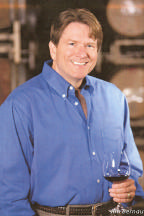 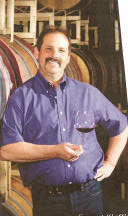 2006 Willamette Valley Vineyards Oregon Riesling 11.5% alc., 21,000 cases, $12. Stainless steel fermented. · Again, some Alsatian influence with petrol in the nose along with pineapple scents. Light and tangy, with lively acid. A skosh sweet with a long finish. Perfectly fine.
2006 Willamette Valley Vineyards Pinot Gris 13.5% alc., 21,000 cases, $15. 7% Pinot Blanc, 1% Auxerrois, 1% Muscat. Stainless steel fermented. · An Alsatian-styled Pinot Gris reminiscent of a fine Tokay Pinot Gris. A rich and potent nose of tropical fruits including banana and pears. Tropical flavors follow in step with attractive minerality and excellent acidity. Quite good.
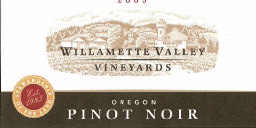 2005 Willamette Valley Vineyards Oregon Pinot Noir 13.5% alc., 16,731 cases, $25. Fermented in 10 ton stainless steel fermenters (the winery has more than 100 of them!), aged in 20% new French oak. Multiple clones including Dijon 113, 114, 115, 667 and 777, Pommard and Wädenswil. Aged 11 months in 20% new oak. · A lighter style of Pinot Noir loyal to its varietal character. Scents of red cherries and toasted nuts with a hint of oak are followed by simple but satisfying cherry flavors which lead to a soft landing at the finish. Nicely balanced. Not extraordinary, but perfectly fine at the dinner table. Remarkable quality for a wine produced in such large quantity.
2005 Willamette Valley Vineyards Estate Vineyard Pinot Noir 14.0% alc., 1,958 cases, $40. This wine is composed of the finest barrel lots from Estate vineyards. Dijon 667, 777, Pommard and Wädenswil clones. Fermented in stainless steel and aged in 35% new French oak. · This wine is dominated by oak as many reserve type bottlings are. The tart cherry fruit is embellished by plenty of earth and mineral notes. The texture is soft and pleasing but the finish retains some astringency. Tasted twice.
Willamette Valley Vineyards address is 8800 Enchanted Way SE, Turner. The phone is 503-588- 9463. The wines are widely distributed on the United States and sold on the winery’s website at www.WillametteValleyVineyards.com. A tasting room is open from 11-6 daily. Tours are by appointment. The winery also offers a Whole Cluster Pinot Noir ($19) and a Signature Cuvée Pinot Noir (sold out).
Argyle WineryEstablished in 1987, Argyle farms over 350 acres in both the Dundee Hills and Eola Hills-Amity District AVAs. The co-founders are Texan Rollin Soles and Australian Brian Croser. Rollin Soles earned a Master’s Degree in Enology at University of California Davis and met Croser while working in Australia. In 2000, Croser’s Petaluma Winery in Australia purchased Argyle. The winery’s focus is on farming vintage-driven wines from great sites. 500 acres of vineyards are currently under the direction of viticulturist Allen Holstein. The three major vineyards are the 120-acre Knudsen Vineyard planted in 1972-1974, the 8-acre Stoller Vineyard planted in 1995, and the 160-acre Lonestar Vineyard located 15 minutes south of Dunee and planted primarily to Dijon clones. In most vintages there are four Pinot Noirs produced: Willamette Valley, Reserve, Nuthouse and Spirithouse. Nuthouse is a uniquely styled Pinot Noir (nutty if you will) that is intense and bold. It takes its name from the original winery which was housed in a previous hazelnut processing plant. The primary source of the Nuthouse Pinot Noir is the Lonestar Vineyard. Spirithouse is a more subtle and silky style. The name comes from the fact that the current tasting room is housed in the former Dundee City Hall which is said to be inhabited by the ghost of a troubled women (the full story is available on the website).
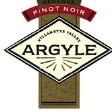 2006 Argyle Willamette Valley Pinot Noir 14.0% alc., 3,156 cases, $25, screw cap. Double-macerated on the skins - once before fermentation cold and then again after fermentation to extract flavor and produce a silky texture. On the label: “To open: Hold cap, then twist bottle.” · Light in color. Tutti-fruiti aromas of red cherry and strawberry and a hint of tropical fruits. Soft in texture, light in weight, featuring simple red fruits. A quaffer that is not meant for contemplation.
2005 Argyle Reserve Willamette Valley Pinot Noir 14.0% alc., $35, 4,900 cases, screw cap. From 8 of the best vineyard blocks. · Hi-toned and bright black cherry and Xmas spice scents. Yummy cherry flavors with a little citrus tang. Velvety and rich in texture with cleansing acid on the finish. A little more hedonistic than the Nuthouse. Not terribly complex, but drinks beautifully.
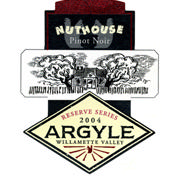 2004 Argyle Nuthouse Willamette Valley Pinot Noir 14.5% alc., $45, screw cap. Primarily sourced from the Lonestar Vineyard. · Cherry driven on the nose and echoed in the flavors with a subtle oak and cranberry sidecar. A lighter style with silky tannins that is pretty good but a bit austere.
 2004 Argyle Spirithouse Dundee Hills Willamette Valley Pinot Noir 14.5% alc., 1,810 cases, $65, screw cap. Sourced from the Knudsen Vineyard. · Cherry and herbs aromas up front with farmyard in the background. Flavors veer toward dark berries, soy and game. Plenty of fruit but still nicely proportioned and a delight to drink.
Argyle Winery is located at 691 Highway 99W in Dundee. The tasting room is open daily from 11-5. The wines are sold on the website and distributed nationally by Terlato Wines International. Soles also crafts exceptional sparkling wines. 1-888-4-ARGYLE. The website is www.argylewinery.com.
ROCO Wines In 1987, Rollin Soles hatched the Argyle Winery and this same year he purchased a hillside property in the Chehalem Mountains. It was many years later, in 2001, that Rollin and his wife Corby planted a 7-acre Pinot Noir vineyard on the property and named it Wit’s End Vineyard. The vineyard is uniquely situated to take advantage of the protection afforded by the Chehelam Mountains which shield the vineyard from winter Artic winds and the Dundee Hills to the south which temper the wind from the Pacific Ocean. The vines are planted to a high density and three Dijon clones make up the mix. The Wit’s End Vineyard has been a family project of great pride and Rollin and Corby farm the property with utmost care and attention. Beginning in 2003, they produced four barrels of Pinot Noir meant for family and friends under the ROCO (rock-oh) label and called Private Stash. Beginning in 2004, Soles has crafted two Pinot Noirs, a ROCO Willamette Valley bottling and the ROCO Private Stash. A small amount of the wines is released to the public each vintage. The thunderbird image on the ROCO label is a reproduction of an ancient petroglyph removed from the Columbia River George in the 1950s. The bird image is said to represent the “wild essence and intriguing history of the Pacific Southwest and ROCO wines.” I tasted both the 2005 ROCO Willamette Valley Pinot Noir and the 2005 ROCO Private Stash Pinot Noir and found the wines highly unique, stunning in style and polish, complex and layered, and possessing lovely depth and richness of fruit. I am embarrassed to say that I misplaced my tasting notes (the first time that I can remember ever doing this) which were filled with superlatives, so I will include the notes of Rollin Soles. I was so taken by these wines that I went out the following day and purchased several bottles of each.
 2005 ROCO Willamette Valley Pinot Noir 14.5% alc., $40. A blend of the winemaker’s favorite Willamette Valley Vineyards including the Wit’s End Vineyard. · Soles says: "I like the ruby red 2005 Willamette Valley Pinot Noir already. The nose reveals violet, deep black cherry, mother’s roast beef and red currant jelly. I get the red currant in the front of the mouth, a mineral sweet center, and the finish is black cherry that includes a long hint of cinnamon with gripping, youthful tannins."
 2005 ROCO Prviate Stash Willamette Valley Pinot Noir 14.5% alc., 100 cases, $70. · Soles says: "In the nose I get a bit of black licorice, plum cake and black pepper that flows effortlessly to black cherry as it has time to open in the glass. In the mouth, the wine is juicy with flavors of pomegranate and plum juices. Its center is spicy with bits of licorice, a touch of pepper and a long sweet fruitcake finish."
ROCO Pinot Noirs are available in limited quantities on the website at www.rocowines.com. 503-538- 7625. Recently, a vertical of all three of the Private Stash Pinot Noir vintages were offered for sale on the website.
Brandborg: A Gem Off the Beaten TrackI met Terry and Sue Brandborg at last year’s International Pinot Noir Celebration where they were proudly pouring their Pinot Noirs as one of the featured wineries. I could see their passion for wine in their eyes and recorded an interview for Grape Radio which will air this month. Terry started out his winemaking career in California, crafting Pinot Noir from the Russian River Valley, Santa Maria Valley and Anderson Valley. He met Sue at a wine tasting event in Wyoming and soon they came together to search for the perfect spot to grow Pinot Noir. They fell in love with rural Elkton in the Umpqua Valley, which is located south of the better known Willamette Valley in Oregon (see map on page 18). The Umpqua Valley actually has an interesting viticultural history. Richard Sommer came to the area in 1961 from California and ushered in the modern era of Oregon’s wine industry when he settled in Roseburg in the southern Umpqua Valley and started Hillcrest Vineyard. He planted Riesling in 1961 and was the first to produce commercial quality wine in Oregon. Sommer has been largely forgotten, because most winegrowers followed David Lett to the Willamette Valley, 180 miles to the north. In 1972, Henry Estate and Giradet Wine Cellars were established in the Umpqua Valley and continue in business to the present. The Henry Estate is famous for the Scott Henry trellising system which was developed by Scott Henry to allow good air movement between canopies and increased fruit exposure to the sun. The trellising proved particularly useful for high-yielding vines. Viticulturalist Dr Richard Smart from New Zealand visited Henry Estate and he carried the trellising system to his native country. The Scott-Henry trellising system is now widely used in New Zealand and Australia. 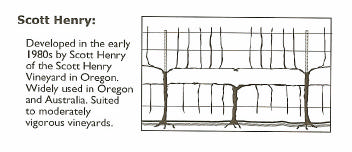 Since 1979 the Steamboat Pinot Noir Conference has been held at the Steamboat Inn on the North Umpqua River. This conference started out as a winemakers-only event for Oregon Pinot Noir specialists and over the years has expanded to include winemakers from Pinot Noir growing regions worldwide. No trade, press or consumers are allowed at this event. There are now 16 wineries and 29 vineyards in the Umpqua Valley. With multiple microclimates, both cool and warm climate varietals thrive here. Terry and Sue chose to settle in Elkton, the coolest part of the Umpqua Valley. (Today while writing this feature I checked the weather in Elkton: the forecast is for snow the next three days and highs of 43° F and lows of 35° F. See photo of Terry in the snow on page 19). Here the geography allows for a significant maritime influence which moderates the warm summers. The Brandborgs chose a site 4 miles southeast of the town of Elkton where the marine sedimentary sandstone soils are well-drained, the elevation (750-1000 ft) is above the fog line, and the southern exposures are ideal. They planted the 50-acre estate Ferris Wheel Vineyard to primarily Dijon clones of Pinot Noir. A winery was built in time for the 2002 vintage and a tasting room opened. 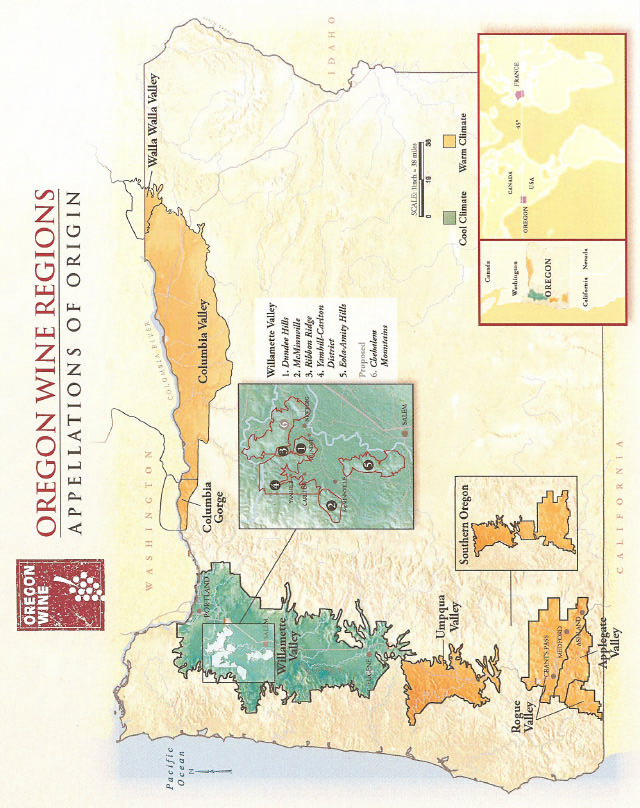  
2006 Brandborg Vineyard & Winery “Love Puppets” Umpqua Valley Pinot Noir 14.3% alc., 800 cases, $30. The grapes for this wine come from favorite dry farmed vineyards, all with yields below 2 tons per acre. The wine represents the best of the grapes they bring in from diverse growers. · If the Benchlands is a buck private, this is a sergeant demanding more attention. Similar, but more intense aromas of wild berries, spice, forest floor and a subtle touch of oak. A little more full-bodied, very smooth on the mid-palate with very decent acidity. Sweet red berry flavors. Commendable balance.
2006 Brandborg Vineyard & Winery Estate Ferris Wheel Vineyard Umpqua 13.8% alc., 452 cases, $38. As the estate Ferris Wheel Vineyard develops, the wines become more deep and satisfying. · Deep ruby color. Dark cherries dominate the aromatics with woodsy and damp earthy touches. Luscious black cherry aftertaste that lasts and lasts. Impeccably balanced with a full and sensual mouth feel. Oak, alcohol, acid and tannins are harmonious. I really like this for its powerful charisma.
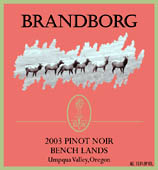 2005 Brandborg Vineyard & Winery Benchlands Umpqua Valley Pinot Noir 14.3% alc., 2,961 cases, $22, screw cap. This blend is sourced from several Umpqua Valley vineyards. All of Brandborg’s Pinots are made the same way: small lots fermented separately with hand punch downs, gently pressed and barreled “dirty” to 100% French oak, 33% new. This is the winery’s value bottling. · Attractive wild berries in the nose. Plenty of likeable berry flavors, especially strawberry, with a little spice and an earthy, mineral bent. Light on its feet and easy to drink.
Brandborg Vineyard & Winery is located at 345 First St, Elkton. The phone is 541-584-2870. Order the wines on the website at www.brandborgwine.com (the 2006 wines will be released in a few months). The tasting room is open 11-5 daily and the winery often features special tastings including entertainment from local musicians. Definitely worth a detour from the Willamette Valley. 
Grochau CellarsI have to lean on Michael Alberty of Story Teller Wine Company in Portland, Oregon for the story on Grochau (pronounced grow-shaw) Cellars which is a new producer with a fledgling and unfinished website. Apparently noted wine writer Matt Kramer touted Grochau Cellars wines by saying, “A couple of sips will tell you he’s a purist winemaker interested in finesse, nuance and what can admiringly be called a certain tenderness (Some other Oregon winemakers strive for power and what might be called a “smash mouth” effect.).” Michael Alberty is a retailer (meaning they can get carried away and hype just about any wine that they have for sell) but I respect the wines he recommends. John Grochau (it would have been easier to name his wines John’s Cellars, but that would have been boring) learned his winemaking craft under Doug Tunnell at Brick House Wines and it doesn’t get much better than that. (Grochau is also the sommelier at Higgins Restaurant in Portland).. Michael feels that John’s wines reflect Tunnell’s hands off approach and “the wines are thoughtfully made, thoughtfully priced and a true expression of the grape variety from which it came.” Alberty and Grochau (and Grochau’s wife Kerri) graduated from Sunset High School in Beaverton, Oregon, so Alberty naturally has a soft spot for these wines. He sent me several to sample and since I don’t have any ax to grind, I can honestly say these are wines worth your interest. 
2006 Grochau Cellars Toute De Suite Willamette Valley Pinot Noir 14.5% alc., $18. The name of this wine is from the French, “at once, right now.” A wine meant to be enjoyed now, not later. · The scents are true to Pinot Noir with dark cherries, smoke and clove. Simple cherry, earth and wood flavors are soft on the palate and the whole package ends in a clean and refreshing finish. Easy to like, easy to drink.
2006 Grochau Cellars Willamette Valley Pinot Noir 14.5% alc., $24. This is Grochau’s entry level serious Pinot Noir but that doesn’t mean it is wimpy. It is a blend of fruit from multiple vineyards. · The aromatics are striking with dark berries and plums showing off. Dark fruits continue on the palate with oak and mushroom nuances. The after taste of black Pinot fruits is haunting and lengthy. A lot of pinotosity.
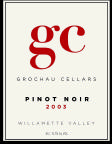 2006 Grochau Cellars Cuvee Des Amis Willamette Valley Pinot Noir 14.5% alc., $36. Sourced from five different vineyards. · A lovely, but demure, nose of dark fruits that need coaxing. A big gulp of dark cherries and blackberries with a subtle hint of oak. Harmonious from start to finish, but reluctant at this stage. Cellaring will be rewarded.
2005 Grochau Cellars Anderson Family Vineyard Willamette Valley Pinot Noir 13.8% alc., 25 cases, $35. The Anderson Family vineyard is planted to Dijon clone 667 in the Yamhill-Carlton District. · Prominent oak char that runs through the wine from start to finish. Big in the mouth, the plush dark berry fruit has an appealing earthiness. The wine possess fine-grained tannins and a clean finish. It is a little too oaky for me at this time but the oak may integrate better with time.
Grochau Cellars is based in Newberg. The wines are available in Oregon restaurants and from Oregon retailers like www.storytellerwine.com. The website, www.gcwines.com, is rudimentary. The phone is 503-522-2455.
Belle PenteBelle Pente (“beautiful slope”) is owned by Brian and Jill O’Donnell. They farm an historic 70-acre estate two miles east of Carlton in the Yamhill-Carlton District. The estate now has 12 acres of closely planted Pinot Noir which is farmed with organic and biodynamic principles. Famed viticulturist Wayne Cook oversees the farming. The first vines were planted in 1994 and the first wines were produced in 1996. the O’Donnells work out of their own 3-level gravity flow winery. I have been a fan of Belle Pente Pinot Noirs from some time now and their wines have been consistently outstanding. Last year, they were one of the featured wineries at the International Pinot Noir Celebration and poured their 2004 Estate Reserve Pinot Noir. Brian is from New York City and Jill grew up in St. Cloud, Minnesota. They met while pursuing careers in Silicon Valley, California. On the eve of the Loma Prieta earthquake in 1989, they resolved to move and begin a career making wine. They arrived in the Willamette Valley in 1992. Their name has not been as highly-profiled like several in Oregon (Brian is soft spoken), but their Pinot Noirs are top rate.
2005 Belle Pente Murto Vineyard Dundee Hills Pinot Noir 12.9% alc., 200 cases, $35. Robin and Mike Murto established their vineyard in 1978. Yields for 2005 were .56 tons per acre. 10th consecutive vintage from this vineyard. This wine spends 18 months in barrel. · Huge, and I mean huge black cherry aromas that are intoxicating. Darker fruits on the palate with a nice touch of earthiness and oak. Very smooth in texture. Lingering fruity aftertaste with a hint of pepper. Kissed by an angel.
2005 Belle Pente Yamhill-Carlton Willamette Valley Pinot Noir 13.9% alc., $35, 18 months in barrel. · Enticing aromatics featuring spiced cherries and oak. Delicious cherry fruit with an oak sidecar. Well put together with lively acidity ideal for food accompaniment.

Small Sips of the RestIn no particular order, here are a number of other Oregon Pinot Noirs I sampled recently. As you have probably surmised from the previous notes, there is basically a two-tier system for Oregon’s Pinot Noirs. Most wineries produce a Willamette Valley or Oregon blend which is an entry level Pinot Noir that provides excellent drinking for the money (usually priced in the $17-$27 range). A step up in quality, complexity, and interest are the reserve wines and vineyard-designate bottlings which can be quite expensive. The point is, there is good drinking at every price point.
2006 Pudding River Wine Cellars Estate Willamette Valley Pinot Noir 14.5% alc., 450 cases, $30, screw cap. The label jokes, “Life is good, the palate is pleased, and the rooster crows again.” · Lightly colored. Attractive scents of cherries, raspberries and wood spice. The flavors replicate the aromas with notable oak influence. Lively acid on the refreshing finish.
2005 The Four Graces Willamette Valley Pinot Noir 13.9% alc., $21. · Cherry, oak and barnyard scents with the oak carrying through to the finish. Very light in body, even shallow in fruit with a clean but stem-infused finish.
2005 Van Duzer Estate Willamette Valley Pinot Noir 12.5% alc., $24. · Sweet and floral scents with some farmyard and animale. Succulent blue and black fruits, tangy acidity and commendable balance.
2005 Lemelson Vineyards Thea’s Selection Willamette Valley Pinot Noir 13.5% alc., $26. · The oak jumps out in the nose and dominates the wine throughout. A dark and one-dimensional fruit-driven wine with significant drying tannins on the finish.
2005 Stevenson-Barrie Shea Vineyard Willamette Valley Pinot Noir 13.5% alc., $32. · I could not warm up to the aromatics that showed pomegranate, green leaf and oak char. Appealing blue and black fruits, good balance, and a slightly dry finish.
 2005 De Ponte Cellars Dundee Hills Pinot Noir 14.2% alc., $38. · The aromatics blossom with coaxing to reveal deep cherries, violets and vanillin oak. Very elegant in style with charming spiced red fruits, soft texture and diaphanous finish. I like this a lot for its Vosne-Romanee character.
2005 Broadley Vineyards Claudia’s Choice Willamette Valley Pinot Noir 13.5% alc., $40. A family- owned and worked winery. This wine comes from a 7 acre distinct block of the estate vineyard. · Black cherries, Asian 5 spice and pencil shavings make up an interesting nose. Slightly jammy and simple fruits with a very healthy tannic backbone. I would lay this one down a few years.
2005 Tori Mor Deux Verres Reserve Willamette Valley Pinot Noir 13.5% alc., 800 cases, $43. A blend of fruit from the Dundee Hills (70%), Chehalem Mountains, and Eola-Amity Hills. The name Deux Verres means “Two Glasses” in French. Winemaker is Jacques Tardy. · Red Pinot fruits power this wine from start to finish. Bright, sweet cherries are the star and pie crust accents fill in. A bit austere and simple but admirable acidity and a soft landing on the finish.
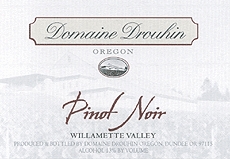 2005 Domaine Drouhin Willamette Valley Pinot Noir 13.9% alc., $45. · Fruit plays a minor role in the nose which shows noticeable oak, earthiness, and mineral- imbibed red cherries.. Demure red fruits are simple with plentiful oak, a strong tannic backbone, soft mouth feel and an acid kick on the backend. Not yet up to the high level of the 2004 vintage of this wine.
2005 Van Duzer Estate Flagpole Block Willamette Valley Pinot Noir 13.5% alc., $45. Note: Van Duzer has had Brett in their wines and it has been part of the Van Duzer ’style,’ especially in the 2002, 2003 and 2004 vintages. In 2004, the Brett aromas were initially masked by the intense fruit, but with time as the fruit intensity dissipated, the Brett became obvious. I believe the problem was curtailed in the 2005 vintage and will be eliminated from the 2006 vintage on when the wines are produced in a newly constructed winery. Although there was no typical Brett aromas in the above wines, the aromatic profiles were a bit unusual and some may find them off-putting. That said, the wines are drinking quite nicely now. · Darkest in color of the three Van Duzer wines. The aromatics are strange, if not unpleasant showing some reduction with vanilla and floral notes and an unidentified chemical component. The dark fruit flavors, however, are luscious and layered, rich but not cloying. Acidity and tannins are reigned in and the whole package is nicely balanced.
2005 Van Duzer Estate Westside Block Willamette Valley Pinot Noir 13.5% alc., $45. · Similar aromatics as above, very floral with added earthiness. Black cherries and black raspberries are a bit tart and the tannins are forefront. The mouth feel is soft and inviting.
2005 Cristom Louise Vineyard Eola-Amity Hills Willamette Valley Pinot Noir 14.0% alc., $48. Composed of five estate vineyards from the 65-acre estate in the Eola Hills. · Entry is different and interesting featuring baked cookies, pumpkin spice and black cherries. This Pinot is cherry fruit-driven with a subtle oak thread running throughout. Very appealing for its finesse and earthiness. Dare I say Burgundian?
 2005 Soter Beacon Hill Yamhill-Carlton District Willamette Valley Pinot Noir 13.7% alc., $48. · Hi-tone red cherry fruit of great purity in the aromatics with a hint of red licorice. Lovely and understated arsenal of cherry fruit, a suave texture and brisk acidity on the finish. A sophisticated wine of great breeding. Still some unresolved tannins - give it 6-12 months to soften. Tres Pinot.
2005 Le Cadeau Vineyard Diversité Willamette Valley Pinot Noir 13.9% alc., $50. Cheryl Francis and Sam Tannahill craft this winemaker-designated cuvee. · Deep, dark ruby color. This is a dark, brooding style of Pinot Noir. Black fruits (plum, blackberry), earth and minerals are evident from start to finish. Full-bodied and straight-forward with a velvety texture. Fans of a bold, plush style will find interest in this wine.
2005 Beaux Freres The Beaux Freres Vineyard Ribbon Ridge Willamette Valley Pinot Noir 13.7% alc., $75. · Deep, dark nose with penetrating plum, black cherry and oak perfume. Packed with tangy and plumy fruit, integrated tannins and brisk acidity on the finish. At present there is more earth and wood than fruit in the aftertaste. Muscular but not harsh. Excellent but not profound.
2004 Domaine Drouhin Laurène Dundee Hills Willamette Valley Pinot Noir 14.1% alc., $65. This wine is made from the finest lots of grapes from Drouhin’s 225-acre estate. It is named after Veronique Drouhin’s oldest daughter. The first vintage was 1992. · Not offering a lot on the nose yet with shy black cherry and wood spice. Solid mélange of black stone fruits with fine-grain tannins. Plenty of French sensibility and the structure to develop nicely over the coming years. Terrific potential that will reward patience.
2003 The Eyrie Vineyards Willamette Valley Pinot Noir 13.0% alc., $25. Winemaker Jason Lett. · Unusual scents of mushroom and sherry. Medium ruby in color and light in weight, the elegant flavors are complex featuring strawberries, leaf, cigar box and sherry. An atypical Pinot Noir that is already showing secondary characters and is not for everyone.
Pinot BriefsA to Z Wineworks A to Z Wineworks in Dundee was founded in 2002 by Sam Tannahill and Bill Hatcher and has become Oregon’s fastest growing winery and now one of the largest producers of Pinot Noir. All of their wines are under $20. Francis Tannahill, who formerly made wine at Archery Summit and has his own premium label with his wife Francis called Francis Tannahill, now says he gets considerable satisfaction out of crafting good, inexpensive wines. Windsor Sonoma Pat Roney, owner of Girard Winery, and Leslie Rudd of Rudd Winery & Vineyards have started a new label, Windsor Sonoma. They are building a new 6,700 sq ft boutique winery and tasting room complex sitting on 40 acres of vineyards in Healdsburg. The label’s first releases include a 2006 Russian River Valley Pinot Noir and will be priced under $30. Roney and Rudd also own Windsor Vineyards where they are raising the quality of wine produced there. Health Warnings on Wine Articles A French court has recently ruled that newspaper articles featuring wines should have to conform to the same health and safety guidelines as alcohol advertising. The court said that articles in favor of alcoholic drinks are advertising and must carry health warnings including the disclaimer: “Alcohol abuse is dangerous to your health.” Naturally French journalists are stunned by this decision and have already started to protest in large numbers. Alcohol Free Wine Alcohol-free wines are made by removing the alcohol through a filter or vacuum process. The resulting wine must have less than one-half of one percent alcohol. Ariel Vineyards sold 1.2 million bottles of alcohol-free wine last year so there is definitely a market for it among pregnant women, designated drivers and abstainers. The alcohol-free wines will not please lovers of good alcoholic wine, but when made with some sweetness as in a white Zinfandel style or a sparkling wine, they can be acceptable. The health benefits do not duplicate that of regular wine as alcohol in moderation has been shown to contribute to the reduction in cardiovascular disease associated with wine. I know of no studies that have compared regular wine drinkers with alcohol-free wine drinkers. Grape Radio on American Airlines Grape Radio internet podcast programs are now included on American Airlines in-flight programming. This is the first wine-related programming on any airline. The first programs will feature Frederick Paniotis of Veuve Clicquot Ponsardin, Margrit Mondavi, and Gaia Gaja of Piedmont. Grape Radio (www.graperadio.com) now has 20,000 listeners and is one of numerous podcasts that are part of a hot trend. MooBuzz label Don Sebastiani & Sons International Wine Negociants is launching a new brand called MooBuzz, which will feature high-end premium Chardonnay and Pinot Noir wines from grapes grown in the Sonoma Coast appellation. The name is taken from the bucolic agricultural lands of the Sonoma Coast appellation - the land of ‘milk and honey’ - thus the the cows and the bees. Moniker. The MooBuzz Pinot Noir will be priced at $25. Don Sebastiani and sons, Donny and August, are third and fourth generation California vintners and merchants. River Road Wine Trail Ten tasting rooms along Monterey’s River Road Wine Trail will be hosting a passport event on Saturday, February 16, from 11 AM to 4 PM. The wineries collectively open for the Valentine’s Passport are Paraiso, Hahn, Pessagno, Marilyn Remark, Scheid, Ventana, Chalone, Manzoni, San Saba and Blackstone. Rare vintages will be offered along with music and food. The Passport ticket price of $25 includes a souvenir glass, a gift of sweets, special discounts on wine and complimentary tastings at participating wineries valid through March 31. The wineries are located along the River Road/Foothill road corridor, on the Santa Lucia bench above the Salinas Valley, just east of Monterey and Carmel. The group’s online home is www.RiverRoadWineTrail.com.
Wine Touring in OregonOregon Multi-Sport Wine Adventure includes five days of activities, wine-related education, and wine tasting from Aug. 10-14, 2008. Attendees hike, bike and paddle canoes through wine country. Sponsored by Zephyr Wine Adventures, the Willamette Valley Visitors Association, Travel Salem, and Visitors Association of Lane County. For information and registration visit www.oregonwineadventure.com. Grape Escape Wine Tours are fun and personalized tours for singles, couples, or small groups lasting from 5 hours to several days. Travel the scenic back roads with experienced guides who educate, drive you to wineries for tours and tastings, and provide gourmet meals along the way. For information visit www.GrapeEscapeTours.com or phone 503-283-3380.
The Long and Winding Pinot Trail, Part IVIn 1977, brothers Ron and Chick Marshall purchased an existing restaurant named Mr Stox in Anaheim, California and converted it into a destination dining Mecca for foodies and wine lovers. They quickly amassed an impressive collection of wine and in 1983 received the Wine Spectator Grand Award, an award they have retained to the present time. Comfortably married and established in my medical practice in the early 1980s, I began to take a renewed interest in wine. I attended many winemaker dinners at Mr Stox, the most memorable of these featured the wines of Domaine Romanee-Conti (DRC). I had became interested in Chalone Pinot Noir. Chalone had developed a cult following in the 1970s and the wines were quickly snapped up by wine fanciers of the time. Owner and winemaker Richard Graff had purchased the Chalone property which was located on a wind-swept plateau in the Gavilan Mountains, a remote outpost 50 miles east of Monterey. Graff chose the site because of its volcanic soil underlain with limestone. Graff’s winemaking was modeled after Burgundy and his Pinot Noirs reminded me of the DRC wines I had tasted at Mr Stox. The Chalone Pinot Noirs were fermented with stems giving them structure. They were aged 18-24 months in the same French oak barrels that were used at DRC. The barrels were kept in caves that were cool and dark. Later, the wines were put into special bottles made in France from a special Burgundy mold. I was particularly fond of the Reserve Pinot Noirs first produced in 1978. They were focused, tightly-knit, and well-balanced with many layers that revealed themselves slowly with each sniff and sip. The Reserve Pinot Noirs were produced only from old vines on the property and were sold only to shareholders. So, naturally, I became a Chalone shareholder in order to acquire the wines. In the mid 1980s, another winemaker was making a name for himself - Gary Farrell. To be continued… .. |